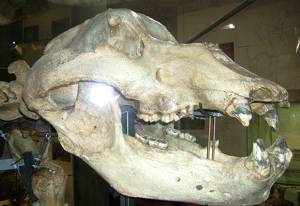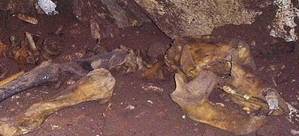Ursus spelaeus
Cave Bear
Online Biology Dictionary
|
|
The prehistoric bears known as cave bears, which were much larger than any living bears, went extinct about 28,000 years ago. They were the contemporaries of neanderthals (Homo neanderthalensis) and early modern humans (Homo sapiens), and probably did battle with them from time to time for ownership of their cavern residences.
These big animals were among the megafauna—including the giant deer, woolly rhinoceros, woolly mammoth and cave lion—that disappeared during the last ice age (but “cave lions” may represent the remains of natural lion-tiger hybrids).

|
| Rosenmüller |
The cave bear was assigned its binomial name, Ursus spelaeus, which in fact means "cave bear," by the German surgeon and anatomist Johann Christian Rosenmüller in 1794. It was one of the most common animals of the Pleistocene. The remains of these animals have been found by the tens of thousands in caves of the more southerly parts of Europe (in the time of the cave bear, northern Europe was submerged in ice and uninhabitable). Indeed, cave bear skeletons are so common that they have been mined industrially as a source of phosphate. Chauvet-Pont d'Arc Cave in France, site of the oldest cave paintings known, contains the remains of thousands of these bears.

|
| Skull of a cave bear |

|
| Remains of Ursus spelaeus in situ at the bear cave near Kletno, Poland. Image: Tatiana of Szczecin |
Externally, cave bears, probably looked a lot like brown bears, Ursus arctos, still living today (see picture, above right). Its skeletal structure, too, was rather similar to that of a brown bear. But they could weigh 30 percent more than the largest brown bear —; sometimes more than a ton. And they also differed from all modern-day bears with respect to certain aspects of their hard anatomy. In particular, the absence of premolars from their dentition sets them apart.
The conclusion that cave bears are closely related to brown bears is based on more than just anatomical similarity. There is DNA evidence as well. Recent studies have determined the complete mitochondrial DNA (mtDNA) sequence for the cave bear, and for several other extinct organisms, such as the prehistoric human Homo neanderthalensis, the Pleistocene mastodon and woolly mammoth — both of which have been found preserved in ice — and two types of moas, gigantic flightless birds, much larger than ostriches, that lived in New Zealand until a few hundred years ago.
Considering the vast quantity of skeletal material preserved in caves and the greatly reduced cost of sequencing today, mtDNA sequences for a wide variety of other extinct animals are probably just around the corner.